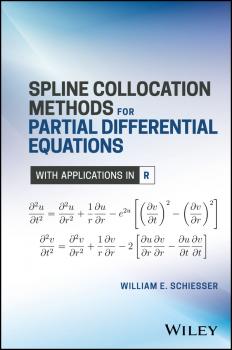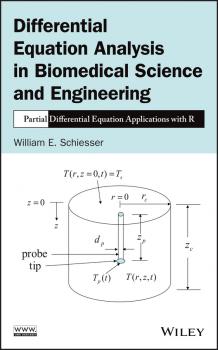William Schiesser E.
Список книг автора William Schiesser E.Method of Lines PDE Analysis in Biomedical Science and Engineering
Presents the methodology and applications of ODE and PDE models within biomedical science and engineering With an emphasis on the method of lines (MOL) for partial differential equation (PDE) numerical integration, Method of Lines PDE Analysis in Biomedical Science and Engineering demonstrates the use of numerical methods for the computer solution of PDEs as applied to biomedical science and engineering (BMSE). Written by a well-known researcher in the field, the book provides an introduction to basic numerical methods for initial/boundary value PDEs before moving on to specific BMSE applications of PDEs. Featuring a straightforward approach, the book’s chapters follow a consistent and comprehensive format. First, each chapter begins by presenting the model as an ordinary differential equation (ODE)/PDE system, including the initial and boundary conditions. Next, the programming of the model equations is introduced through a series of R routines that primarily implement MOL for PDEs. Subsequently, the resulting numerical and graphical solution is discussed and interpreted with respect to the model equations. Finally, each chapter concludes with a review of the numerical algorithm performance, general observations and results, and possible extensions of the model. Method of Lines PDE Analysis in Biomedical Science and Engineering also includes: Examples of MOL analysis of PDEs, including BMSE applications in wave front resolution in chromatography, VEGF angiogenesis, thermographic tumor location, blood-tissue transport, two fluid and membrane mass transfer, artificial liver support system, cross diffusion epidemiology, oncolytic virotherapy, tumor cell density in glioblastomas, and variable grids Discussions on the use of R software, which facilitates immediate solutions to differential equation problems without having to first learn the basic concepts of numerical analysis for PDEs and the programming of PDE algorithms A companion website that provides source code for the R routines Method of Lines PDE Analysis in Biomedical Science and Engineering is an introductory reference for researchers, scientists, clinicians, medical researchers, mathematicians, statisticians, chemical engineers, epidemiologists, and pharmacokineticists as well as anyone interested in clinical applications and the interpretation of experimental data with differential equation models. The book is also an ideal textbook for graduate-level courses in applied mathematics, BMSE, biology, biophysics, biochemistry, medicine, and engineering.
Spline Collocation Methods for Partial Differential Equations. With Applications in R
A comprehensive approach to numerical partial differential equations Spline Collocation Methods for Partial Differential Equations combines the collocation analysis of partial differential equations (PDEs) with the method of lines (MOL) in order to simplify the solution process. Using a series of example applications, the author delineates the main features of the approach in detail, including an established mathematical framework. The book also clearly demonstrates that spline collocation can offer a comprehensive method for numerical integration of PDEs when it is used with the MOL in which spatial (boundary value) derivatives are approximated with splines, including the boundary conditions. R, an open-source scientific programming system, is used throughout for programming the PDEs and numerical algorithms, and each section of code is clearly explained. As a result, readers gain a complete picture of the model and its computer implementation without having to fill in the details of the numerical analysis, algorithms, or programming. The presentation is not heavily mathematical, and in place of theorems and proofs, detailed example applications are provided. Appropriate for scientists, engineers, and applied mathematicians, Spline Collocation Methods for Partial Differential Equations: Introduces numerical methods by first presenting basic examples followed by more complicated applications Employs R to illustrate accurate and efficient solutions of the PDE models Presents spline collocation as a comprehensive approach to the numerical integration of PDEs and an effective alternative to other, well established methods Discusses how to reproduce and extend the presented numerical solutions Identifies the use of selected algorithms, such as the solution of nonlinear equations and banded or sparse matrix processing Features a companion website that provides the related R routines Spline Collocation Methods for Partial Differential Equations is a valuable reference and/or self-study guide for academics, researchers, and practitioners in applied mathematics and engineering, as well as for advanced undergraduates and graduate-level students.
Differential Equation Analysis in Biomedical Science and Engineering. Partial Differential Equation Applications with R
Features a solid foundation of mathematical and computational tools to formulate and solve real-world PDE problems across various fields With a step-by-step approach to solving partial differential equations (PDEs), Differential Equation Analysis in Biomedical Science and Engineering: Partial Differential Equation Applications with R successfully applies computational techniques for solving real-world PDE problems that are found in a variety of fields, including chemistry, physics, biology, and physiology. The book provides readers with the necessary knowledge to reproduce and extend the computed numerical solutions and is a valuable resource for dealing with a broad class of linear and nonlinear partial differential equations. The author’s primary focus is on models expressed as systems of PDEs, which generally result from including spatial effects so that the PDE dependent variables are functions of both space and time, unlike ordinary differential equation (ODE) systems that pertain to time only. As such, the book emphasizes details of the numerical algorithms and how the solutions were computed. Featuring computer-based mathematical models for solving real-world problems in the biological and biomedical sciences and engineering, the book also includes: R routines to facilitate the immediate use of computation for solving differential equation problems without having to first learn the basic concepts of numerical analysis and programming for PDEs Models as systems of PDEs and associated initial and boundary conditions with explanations of the associated chemistry, physics, biology, and physiology Numerical solutions of the presented model equations with a discussion of the important features of the solutions Aspects of general PDE computation through various biomedical science and engineering applications Differential Equation Analysis in Biomedical Science and Engineering: Partial Differential Equation Applications with R is an excellent reference for researchers, scientists, clinicians, medical researchers, engineers, statisticians, epidemiologists, and pharmacokineticists who are interested in both clinical applications and interpretation of experimental data with mathematical models in order to efficiently solve the associated differential equations. The book is also useful as a textbook for graduate-level courses in mathematics, biomedical science and engineering, biology, biophysics, biochemistry, medicine, and engineering.
Differential Equation Analysis in Biomedical Science and Engineering. Ordinary Differential Equation Applications with R
Features a solid foundation of mathematical and computational tools to formulate and solve real-world ODE problems across various fields With a step-by-step approach to solving ordinary differential equations (ODEs), Differential Equation Analysis in Biomedical Science and Engineering: Ordinary Differential Equation Applications with R successfully applies computational techniques for solving real-world ODE problems that are found in a variety of fields, including chemistry, physics, biology, and physiology. The book provides readers with the necessary knowledge to reproduce and extend the computed numerical solutions and is a valuable resource for dealing with a broad class of linear and nonlinear ordinary differential equations. The author’s primary focus is on models expressed as systems of ODEs, which generally result by neglecting spatial effects so that the ODE dependent variables are uniform in space. Therefore, time is the independent variable in most applications of ODE systems. As such, the book emphasizes details of the numerical algorithms and how the solutions were computed. Featuring computer-based mathematical models for solving real-world problems in the biological and biomedical sciences and engineering, the book also includes: R routines to facilitate the immediate use of computation for solving differential equation problems without having to first learn the basic concepts of numerical analysis and programming for ODEs Models as systems of ODEs with explanations of the associated chemistry, physics, biology, and physiology as well as the algebraic equations used to calculate intermediate variables Numerical solutions of the presented model equations with a discussion of the important features of the solutions Aspects of general ODE computation through various biomolecular science and engineering applications Differential Equation Analysis in Biomedical Science and Engineering: Ordinary Differential Equation Applications with R is an excellent reference for researchers, scientists, clinicians, medical researchers, engineers, statisticians, epidemiologists, and pharmacokineticists who are interested in both clinical applications and interpretation of experimental data with mathematical models in order to efficiently solve the associated differential equations. The book is also useful as a textbook for graduate-level courses in mathematics, biomedical science and engineering, biology, biophysics, biochemistry, medicine, and engineering.
Differential Equation Analysis in Biomedical Science and Engineering. Ordinary Differential Equation Applications with R
Features a solid foundation of mathematical and computational tools to formulate and solve real-world ODE problems across various fields With a step-by-step approach to solving ordinary differential equations (ODEs), Differential Equation Analysis in Biomedical Science and Engineering: Ordinary Differential Equation Applications with R successfully applies computational techniques for solving real-world ODE problems that are found in a variety of fields, including chemistry, physics, biology, and physiology. The book provides readers with the necessary knowledge to reproduce and extend the computed numerical solutions and is a valuable resource for dealing with a broad class of linear and nonlinear ordinary differential equations. The author’s primary focus is on models expressed as systems of ODEs, which generally result by neglecting spatial effects so that the ODE dependent variables are uniform in space. Therefore, time is the independent variable in most applications of ODE systems. As such, the book emphasizes details of the numerical algorithms and how the solutions were computed. Featuring computer-based mathematical models for solving real-world problems in the biological and biomedical sciences and engineering, the book also includes: R routines to facilitate the immediate use of computation for solving differential equation problems without having to first learn the basic concepts of numerical analysis and programming for ODEs Models as systems of ODEs with explanations of the associated chemistry, physics, biology, and physiology as well as the algebraic equations used to calculate intermediate variables Numerical solutions of the presented model equations with a discussion of the important features of the solutions Aspects of general ODE computation through various biomolecular science and engineering applications Differential Equation Analysis in Biomedical Science and Engineering: Ordinary Differential Equation Applications with R is an excellent reference for researchers, scientists, clinicians, medical researchers, engineers, statisticians, epidemiologists, and pharmacokineticists who are interested in both clinical applications and interpretation of experimental data with mathematical models in order to efficiently solve the associated differential equations. The book is also useful as a textbook for graduate-level courses in mathematics, biomedical science and engineering, biology, biophysics, biochemistry, medicine, and engineering.




